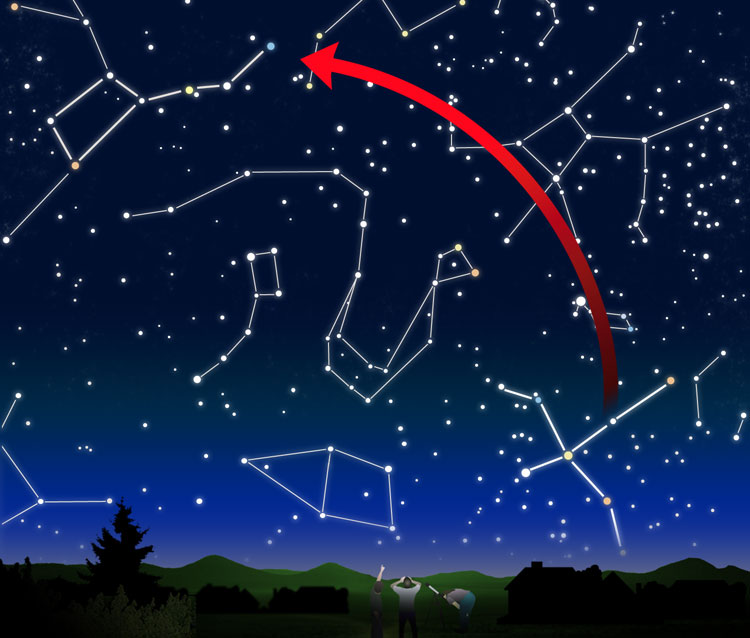Exit Strategy: Neutron Star Kicked Out of Milky Way

Thanks to the kick itreceived from a supernova, the fastest known neutron star is speeding out ofthe Milky Way.
Most stars in the Milky Waylie in a fairly concentrated plane, varying only by plus or minus five degrees.
Two-and-half million yearsago, a massive star in the constellation Cygnus--a collection of giant starswithin the galactic plane--went supernova. As the star collapsed, the resultinghuge explosion gave a powerful "kick" to the neutron star that formeddeep inside the supernova.
Now, at 52 degrees latitudeand about 7,700 light-years from Earth, the neutron star B1508+55 is well outof the galactic plane. And although it's the fastest neutron star everobserved--traveling at 670 miles-per-second (1,100 km/s) it could make the tripfrom New York to Los Angeles in under 4 seconds--it will still be sometimebefore it leaves the galaxy.
"It's on its wayout," Shami Chatterjee of the National Radio Astronomy Observatory and theHarvard-Smithsonian Center for Astrophysics told SPACE.com. "Inmaybe another million or so years it will leave what we nominally think of asour galaxy."
This discovery could settlethe argument over how fast an imbalanced supernova explosion can send a neutronstar flying.
"We've thought forsometime that supernova explosions can give a kick to the resulting neutronstar, but the latest computer models of this process have not produced speedsanywhere near what we see in this object," said Chatterjee.
Breaking space news, the latest updates on rocket launches, skywatching events and more!
Three-dimensional computermodels, run for the first time this past year, predict ejecting neutron starspeeds of only 122 miles-per-second (200 km/s). In computer simulations,material from the outer layers of the collapsing massive star crashes into theneutron star as it's on its way out.
But these simulationsfactor in variables based on estimations. Speeds predicted by these simulationsaren't reliable, says Chatterjee. His measurement, based on pure geometry, ismuch more accurate.
"It's a straightforward measurement of velocity," Chatterjee said. "Once we know howfar away the star is, and we know how much physical space it's covered in twoyears, we can translate that into kilometers per second."
To determine B1508+55'sspeed, astronomers first had to figure out how far it is from Earth. Theyaccomplished this using the National Science Foundation's Very Long BaselineArray (VLBA) radio telescope and a trick from high school geometry--parallax.
If you don't rememberparallax, it's a way of determining how far away an intermediate object isusing two viewing points, a background of known distance, and the anglesbetween all these objects. Here's an example:
First, stand five feet froma wall. Now, hold up one finger arm's length from your face. As you focus onthe wall, each eye sees the finger slightly differently. Using thesedifferences, the known distance from eye to eye and the distance and angle fromeye to wall, you can figure out how far away your finger is.
"Here, the wall thatit's compared against is the background galaxies. Instead of two eyes, we usedpositions of the Earth six months apart, on either side of the sun,"Chatterjee said. "Since we know these other distances very accurately, andwe know the angle, we can get a very accurate measurement. It's straightgeometry."
Once they determined thedistance between Earth and the neutron star, they used the VLBA to track howfar it moved across the sky in a given time. Fortunately the VLBA specializesin making observations on the tiniest scales.
"The motion we measuredwith the VLBA was about equal to watching a home run ball in Boston's FenwayPark from a seat on the Moon," Chatterjee said.
With this information inhand, Chatterjee determined that this object is traveling at 1,100 km/s (670miles/s), the fastest speed yet recorded for a neutron star.
Since these measurementsare based on geometry, they're hard to argue with, Chatterjee says. Thecomputer simulations, he adds, may need to be corrected to account for thisobservation.
Once Chatterjee calculatedhow fast it was going, he estimated the neutron star's age at about 2.5 millionyears old and began tracking it backwards to determine its origin.
"We have a veryaccurate distance and a very accurate velocity vector for the star. If youtrace it back, it comes back straight to the galactic plane to a cluster ofvery massive stars," Chatterjee said. "It shot right out of thegalactic plane."
Although Chatterjeebelieves the neutron star was thrown out of the Cygnus constellation, he saysthere is another way it may have gotten this much speed--binary disruption.Massive stars often exist in pairs, spinning furiously and held together by aband of gravity. When one of the stars goes supernova, this shock disrupts thegravity tie and sends both stars flying in opposite directions.
"It doesn't look likeyou can get 1,100 km/s through this process," Chatterjee said."Probably only 600 km/s (366 miles/s) from binary disruption. At 1,100km/s, most people will say there must be a supernova kick involved."
This observation was partof a long-term project to use the VLBA to measure the distances and speeds ofnumerous pulsars. The VLBA is a system of 10 radio-telescope antennas, eachwith a dish 25 meters (82 feet) in diameter. The VLBA spans over 5,000 miles -from Mauna Kea on the Big Island of Hawaii to St. Croix in the U.S. VirginIslands - providing astronomers with the sharpest vision of any telescope onEarth or in space.
